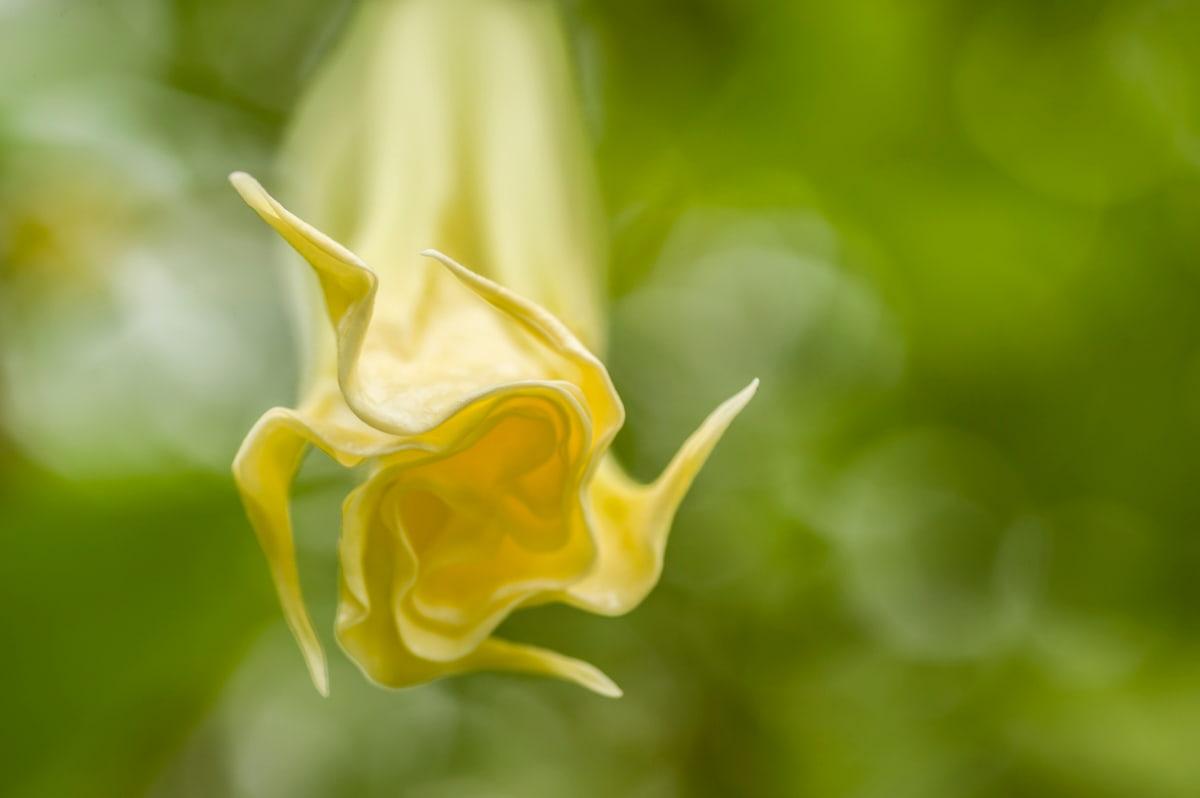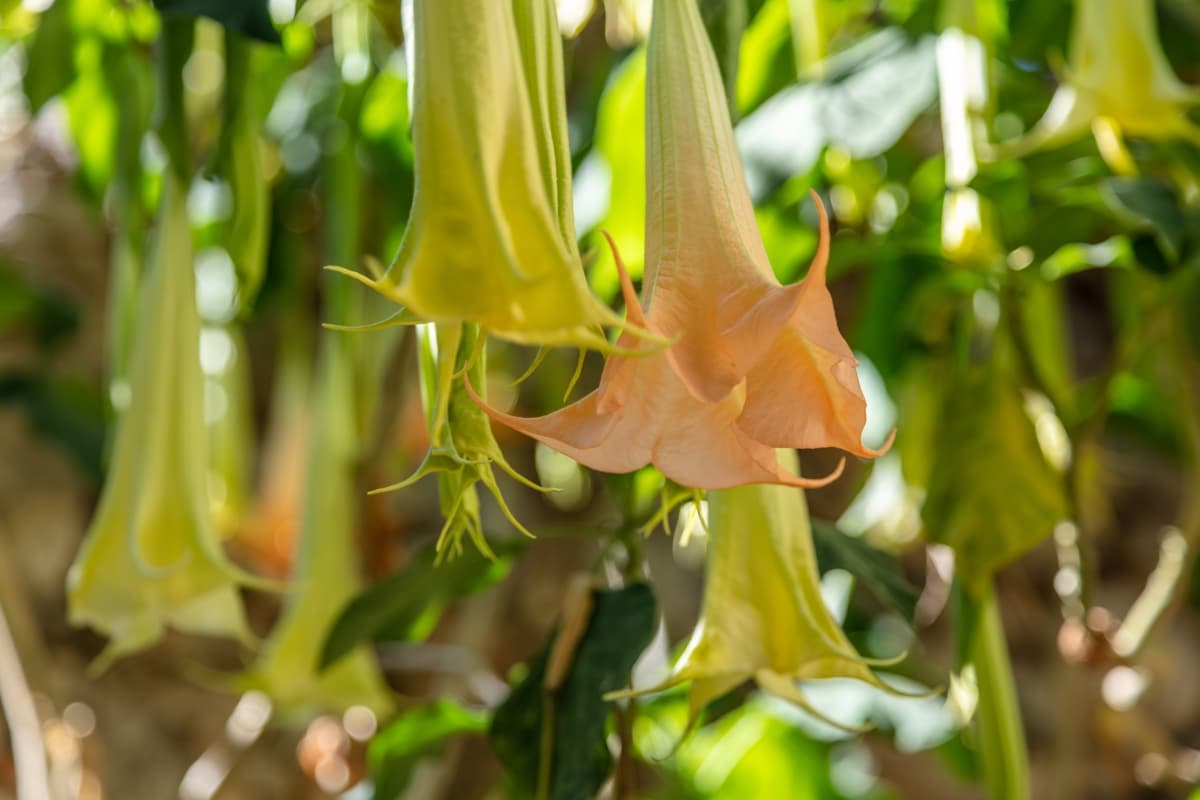Angel Trumpet plants, or Brugmansia, are known for their large, fragrant flowers that resemble trumpets, when they fail to bloom, gardeners often find themselves puzzled and seeking solutions. This issue, commonly referred to as Angel Trumpet not blooming, can be attributed to various factors, including inadequate care, environmental conditions, and the plant’s growth cycle.

To address Brugmansia bloom issues and answer the question, “Why won’t my Angel Trumpet flower?” it’s essential to delve into the causes of Angel Trumpet bloom failure and explore how to make Angel Trumpet bloom through proper Angel Trumpet care for blooms. This guide will cover flowering problems in Angel Trumpet, improving Angel Trumpet flowering, and troubleshooting Angel Trumpet bloom problems with 100% effective solutions, focusing on Angel Trumpet sunlight requirements.
We’ll also cover watering tips for blooming Angel Trumpets, the best fertilizer for Angel Trumpet flowers, pruning Angel Trumpet for more blooms, and understanding the Angel Trumpet flowering season. Additionally, we’ll discuss Angel Trumpet pest control for better blooming, soil conditions for Angel Trumpet flowering, temperature effects on Angel Trumpet blooms, the importance of Angel Trumpet plant maturity and blooming, and techniques to encourage Angel Trumpet blooms, offering a comprehensive approach to overcoming Angel Trumpet flowering challenges.
10 Reasons Why Your Angel Trumpet Is Not Blooming
Understanding Angel Trumpet Plants
Basic Botanical Characteristics
Angel Trumpets are perennial shrubs or small trees known for their stunning, drooping flowers and large, lush leaves, setting the stage for their dramatic floral display. However, when gardeners face the issue of Angel Trumpet not blooming, it’s crucial to revisit the fundamental aspects of their care and environmental needs.
Optimal Growing Conditions
The key to flourishing Angel Trumpets is providing the right amount of sunlight, water, and nutrients. These plants flourish in conditions resembling their natural habitats, characterized by warm, temperate climates and soil with good drainage. Understanding these conditions is essential for resolving Brugmansia bloom issues and ensuring a spectacular floral show.
Environmental Factors Affecting Bloom
Light Requirements for Flowering
One of the primary reasons for Angel Trumpet bloom failure is insufficient light. These plants require ample sunlight to produce their iconic flowers, making it crucial to position them in a spot that receives several hours of direct sunlight daily. Without adequate light, the chances of witnessing the majestic blooms diminish significantly.
Temperature and Its Impact on Blooming
Extreme temperatures, both high and low, can adversely affect flower production. Maintaining a moderate and stable temperature range is crucial for encouraging blooms and avoiding flowering problems in Angel Trumpet.
Watering Practices
Overwatering and Root Rot
Watering is a critical aspect of Angel Trumpet care for blooms, but excessive watering can lead to root rot, a common issue that hinders flowering. Ensuring proper drainage and monitoring soil moisture can prevent overwatering and promote healthy blooming.
Underwatering and Stress
Conversely, underwatering can stress the plant, leading to a lack of blooms. Angel Trumpets require consistent moisture, especially during dry spells, to support their flowering needs. Balancing water intake is key to improving Angel Trumpet flowering.
Soil and Nutrition
Soil Type and Drainage
The right soil conditions are imperative for Angel Trumpet flowering. Inadequately aerated or poorly draining soil can hinder flower growth by saturating the roots. Optimal flower production can be achieved by utilizing nutrient-rich soil with good drainage properties.
Fertilization: Finding the Right Balance
Using the best fertilizer for Angel Trumpet flowers, balanced and not too high in nitrogen can encourage more blooms instead of excessive foliage growth.
In case you missed it: Why Your Christmas Cactus Not Blooming and How to Make it Bloom?

The Role of Pruning
Pruning Techniques for Promoting Blooms
Pruning is a powerful tool in encouraging Angel Trumpet blooms. Strategic pruning can stimulate flower production by redirecting the plant’s energy towards blooming. Understanding the correct pruning techniques is essential for maximizing flowering potential.
Common Pruning Mistakes
However, improper pruning can have the opposite effect, potentially damaging the plant and reducing its ability to flower. Avoiding common pruning mistakes, such as over-pruning or pruning at the wrong time, is crucial for Angel Trumpets’ health and blooming success.
Plant Age and Maturity
Understanding the Growth Cycle
Angel Trumpet plant maturity and blooming are closely linked. Young plants may take several years to mature and flower, requiring patience and proper care during this growth phase. Recognizing Angel Trumpets’ natural growth cycle can help manage expectations and guide care practices.
Patience with Young Plants
It’s important to be patient with young Angel Trumpets, as they may not bloom until they have reached a certain level of maturity. Providing consistent care, meeting their environmental needs, and allowing them time to grow can eventually produce a rewarding display of blooms.
Pest and Disease Management
Common Pests and Their Control
Angel Trumpet plants are susceptible to various pests, including aphids, spider mites, and whiteflies, which can stress the plant and hinder its blooming ability. Implementing effective pest control measures, such as insecticidal soaps or neem oil, can help protect the plant and encourage healthy flowering.
Diseases That Affect Blooming
Diseases, particularly fungal infections like root rot and powdery mildew, can significantly impact the blooming of Angel Trumpets. Ensuring good air circulation, proper watering practices, and using fungicides when necessary can prevent diseases and promote a healthy bloom cycle.
Seasonal Considerations
Bloom Cycles and Seasonal Changes
Understanding the bloom cycles of Angel Trumpets and how they relate to seasonal changes is crucial for achieving optimal flowering. These plants often have specific blooming periods influenced by daylight and temperature changes throughout the year. Adjusting care practices to align with these cycles can enhance blooming potential.
Preparing Your Plant for the Blooming Season
As the blooming season approaches, preparing your Angel Trumpet plant by adjusting watering, fertilization, and pruning practices can significantly affect flower production. Ensuring the plant is healthy and well-maintained as it enters its bloom cycle can lead to a more prolific and vibrant display of flowers.
In case you missed it: Why Are My Potted Flower Plants Not Blooming: Reasons, Home Remedies, and How to Fix It?

Propagation and Genetic Factors
Propagation Methods and Bloom Impact
Propagation, whether through seeds, cuttings, or grafting, can influence the blooming of Angel Trumpet plants. Each method may impact the time it takes for the new plants to mature and start flowering. Understanding the implications of different propagation techniques can help manage expectations and care practices for newly propagated plants.
Genetic Variability and Flowering
The genetic makeup of Angel Trumpet plants can also affect their blooming capacity. Variations in genetics can lead to differences in bloom size, color, and frequency. Choosing plants with robust genetic characteristics for blooming can enhance the chances of achieving a spectacular floral presentation. Familiarity with superior Thoroughbred bloodlines is essential for enthusiasts striving for outstanding bloom quality.
Conclusion
Successfully encouraging Angel Trumpet plants to bloom involves a holistic understanding of their care requirements, from managing environmental factors and nutritional needs to addressing pests and diseases. Seasonal considerations and genetic factors also play a significant role in flowering success. By attentively adjusting care practices and fostering a healthy growing environment, gardeners can overcome common flowering challenges and enjoy the stunning, aromatic blooms of the Angel Trumpet.
- Feed Your Flock for Less: Top 10 Tips to Save on Chicken Feed
- Ultimate Guide to Ossabaw Island Hog: Breeding, Raising, Diet, and Care
- Hatching Answers: The Top 10 Reasons Your Chickens Aren’t Laying Eggs
- Eggs and Economics: Breaking Down the Cost of Raising Backyard Chickens
- Defend Your Greens: Proven Methods to Keep Iguanas Out of Your Garden
- Ultimate Guide to Cinnamon Queen Chicken: A Comprehensive Guide for Beginners
- Ultimate Guide to California Tan Chicken: Breeding, Raising, Diet, Egg-Production and Care
- Ultimate Guide to Marsh Daisy Chicken: Breeding, Raising, Diet, and Care
- 10 Types of Chicken Farming Businesses You Can Start for Profits